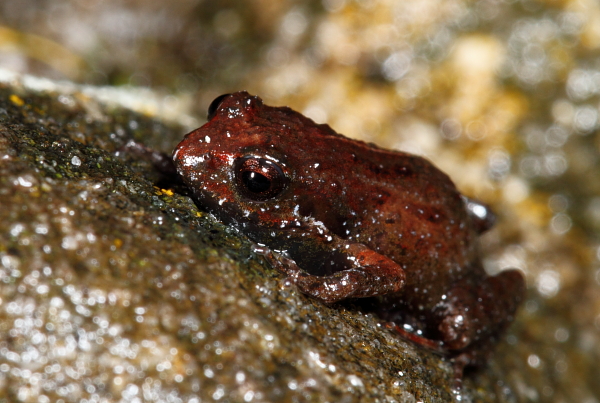View the above photo record (by Megan Loftie-Eaton) in FrogMAP here.
Find the Lightfoot’s Moss Frog in the FBIS database (Freshwater Biodiversity Information System) here.
Family Pyxicephalidae
LIGHTFOOT’S MOSS FROG – Arthroleptella lightfooti
(Boulenger, 1910)
Identification
Adults vary considerably in colouration and markings. Females reach 22 mm in length. The outer metatarsal tubercle is well developed as in Arthroleptella villiersi. The advertisement call is a short chirp consisting of three pulses. The call is 0.1 s long and has an emphasized frequency of 3.1–3.4 kHz (Channing et al. 1994a; Channing 2001). This species does not occur in sympatry with any other Arthroleptella species.
Habitat
This species is restricted to montane fynbos and Afromontane forest in the winter rainfall region, where annual rainfall is >750 mm. It inhabits seepages, both in open fynbos and kloofs, where the vegetation is thick and the substrate is sandy or rocky.
Behaviour
Choruses develop during the daytime and at night, between April and December, coinciding with the rainy season. Males call from concealed sites and are frequently found under moss in the vicinity of egg masses. Clutches of 5–12 eggs are laid on damp soil under vegetation or in more exposed positions, and are often found near waterfalls (Channing 2001). Development is direct and metamorphosis takes place 7–10 days after the eggs are laid.
Status and Conservation
Status
A. lightfooti occurs in the Cape Peninsula National Park and Kirstenbosch Botanical Gardens (Channing 2001; Harrison et al. 2001). Although the limited area of occupancy and extent of occurrence of this species seems to warrant a higher category of threat, its distribution falls almost entirely within the Cape Peninsula National Park and the known sub-populations are not severely fragmented. Major declines are not expected, and the species was therefore classified Near Threatened (Harrison et al. 2001; this publication). While the species is not considered to be under immediate threat, appropriate conservation management practices are necessary to ensure its continued survival.
Threats
Present and potential threats include habitat fragmentation, the alteration of drainage patterns (dam construction), invasive alien vegetation, afforestation and fire (Harrison et al. 2001). These threats are exacerbated by the fact that the area of occupancy is surrounded by a large urban metropolis.
Recommended conservation actions
Habitat and limiting factor management, as well as regular population monitoring, are recommended.
Distribution
A. lightfooti is endemic to the Cape Peninsula. It is known from sea level to 1000 m at the top of Table Mountain. The species appears to be divided into two subpopulations: Table Mountain/Constantiaberg, and the southern Cape Peninsula (Harrison et al. 2001). The atlas data are reliable.

Further Resources
Virtual Museum (FrogMAP > Search VM > By Scientific or Common Name)
More common names: Cape Peninsula Moss Frog, Cape Chirping Frog (Alternative English Name); Kaapse Skiereiland mospadda (Afrikaans).
Recommended citation format for this species text:
Channing A, Tippett RM. Lightfoot’s Moss Frog Arthroleptella lightfooti. BDI, Cape Town.
Available online at http://thebdi.org/2021/11/11/lightfoots-moss-frog-arthroleptella-lightfooti/
Recommended citation format:
This species text has been updated and expanded from the text in the
2004 frog atlas. The reference to the text and the book are as follows:
Channing A 2004 Arthroleptella lightfooti Lightfoot’s Moss Frog. In Minter LR
et al 2004.
Minter LR, Burger M, Harrison JA, Braack HH, Bishop PJ, Kloepfer D (eds)
2004. Atlas and Red Data Book of the Frogs of South Africa, Lesotho and
Swaziland. Smithsonian Institution, Washington, and Avian Demography
Unit, Cape Town.

